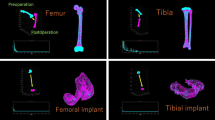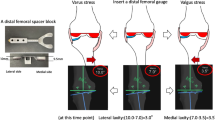Abstract
Purpose
The aim of this study was to test the hypothesis that the medial constrained insert would reproduce the native knee kinematics after bicruciate-retaining (BCR) total knee arthroplasty (TKA).
Methods
Using an image-free navigation system in six fresh-frozen whole-body cadavers, the rotation angle of the tibia at minimum flexion, at 10° intervals from 0° to 130° flexion, and at maximum flexion during manual passive knee flexion was assessed. The data was collected in native knees, in BCR TKA using a normal flat insert (BCR-XP), and in BCR TKA using a more constrained insert in the medial side (BCR-AS). The differences in the rotation angle of the tibia were statistically evaluated.
Results
The rotation angles of the tibia in BCR-XP were significantly different from those of the native knees both in the early flexion phase (p = 0.002 at minimum knee flexion, p = 0.002 at 0°, p = 0.041 at 10°, p = 0.009 at 20°, p = 0.026 at 30°) and in the late flexion phase (p = 0.015 at 130°, p = 0.015 at maximum knee flexion), whereas the rotational angles of the tibia in BCR-AS were similar to those of the native knee.
Conclusion
This study shows that the rotational kinematics of the native knee is reproduced after BCR TKA with the medial constrained insert. Surgeons and implant designers should be aware that constraint of the medial side in BCR TKA is a crucial factor for restoration of native kinematics which may lead to better clinical outcome.




Similar content being viewed by others
Abbreviations
- TKA:
-
Total knee arthroplasty
- UKA:
-
Unicompartmental arthroplasty
- ACL:
-
Anterior cruciate ligament
- PCL:
-
Posterior cruciate ligament
- BCR:
-
Bicruciate-retaining
References
Akagi M, Mori S, Nishimura S, Nishimura A, Asano T et al (2005) Variability of extraarticular tibial rotation references for total knee arthroplasty. Clin Orthop Relat Res 436:172–176
Becker R, Mauer C, Stärke C, Brosz M, Zantop T et al (2013) Anteroposterior and rotational stability in fixed and mobile bearing unicondylar knee arthroplasty: a cadaveric study using the robotic force sensor system. Knee Surg Sports Traumatol Arthrosc 21:2427–2432
Bourne RB, Chesworth B, Davis A, Mahomed N, Charron K (2010) Comparing patient outcomes after THA and TKA: is there a difference? Clin Orthop Relat Res 468:542–546
Christensen JC, Brothers J, Stoddard GJ, Anderson MB, Pelt CE et al (2017) Higher frequency of reoperation with a new bicruciate-retaining total knee arthroplasty. Clin Orthop Relat Res 475:62–69
Cip J, Obwegeser F, Benesch T, Bach C, Ruckenstuhl P et al (2017) Twelve-year follow-up of navigated computer-assisted versus conventional total knee arthroplasty. J Arthroplasty 33:1404–1411
Cohen J (1988) Statistical power analysis for the behavioral sciences. Lawrence Erlbaum Associates, Hillsdale
Dennis DA, Komistek RD, Mahfouz MR, Walker SA, Tucker A (2004) A multicenter analysis of axial femorotibial rotation after total knee arthroplasty. Clin Orthop Relat Res 428:180–189
Faul F, Erdfelder E, Lang A-G, Buchner A (2007) G* Power 3: a flexible statistical power analysis program for the social, behavioral, and biomedical sciences. Behav Res Methods 39:175–191
Hamada D, Wada K, Takasago T, Goto T, Nitta A et al (2018) Native rotational knee kinematics are lost in bicruciate-retaining total knee arthroplasty when the tibial component is replaced. Knee Surg Sports Traumatol Arthrosc. https://doi.org/10.1007/s00167-018-4842-5
Hamai S, Moro-Oka TA, Dunbar NJ, Miura H, Iwamoto Y et al (2013) In vivo healthy knee kinematics during dynamic full flexion. Biomed Res Int 2013:3–6
Heyse TJ, Slane J, Peersman G, Dirckx M, van de Vyver A et al (2017) Kinematics of a bicruciate-retaining total knee arthroplasty. Knee Surg Sport Traumatol Arthrosc 25:1784–1791
Li C, Hosseini A, Tsai TY, Kwon YM, Li G (2015) Articular contact kinematics of the knee before and after a cruciate retaining total knee arthroplasty. J Orthop Res 33:349–358
Moglo KE, Shirazi-Adl A (2005) Cruciate coupling and screw-home mechanism in passive knee joint during extension-flexion. J Biomech 38:1075–1083
Moro-oka T, Muenchinger M, Canciani J-P, Banks SA (2007) Comparing in vivo kinematics of anterior cruciate-retaining and posterior cruciate-retaining total knee arthroplasty. Knee Surg Sports Traumatol Arthrosc 15:93–99
Murakami K, Hamai S, Okazaki K, Ikebe S, Shimoto T et al (2016) In vivo kinematics of healthy male knees during squat and golf swing using image-matching techniques. Knee 23:221–226
Nakagawa S, Kadoya Y, Todo S, Kobayashi A, Sakamoto H et al (2000) Tibiofemoral movement 3: full flexion in the living knee studied by MRI. J Bone Jt Surg Br 82:1199–1200
Nishio Y, Onodera T, Kasahara Y, Takahashi D, Iwasaki N et al (2014) Intraoperative medial pivot affects deep knee flexion angle and patient-reported outcomes after total knee arthroplasty. J Arthroplasty 29:702–706
Okada Y, Teramoto A, Takagi T, Yamakawa S, Sakakibara Y et al (2018) ACL function in bicruciate-retaining total knee arthroplasty. J Bone Jt Surg Am 100:e114
Peersman G, Slane J, Dirckx M, Vandevyver A, Dworschak P et al (2017) The influence of polyethylene bearing thickness on the tibiofemoral kinematics of a bicruciate retaining total knee arthroplasty. Knee 24:751–760
Pritchett JW (2015) Bicruciate-retaining total knee replacement provides satisfactory function and implant survivorship at 23 years. Clin Orthop Relat Res 473:2327–2333
Schiavone Panni A, Falez F, D’Apolito R, Corona K, Perisano C et al (2017) Long-term follow-up of a non-randomised prospective cohort of one hundred and ninety two total knee arthroplasties using the NexGen implant. Int Orthop 41:1155–1162
Stiehl JB, Komistek RD, Cloutier JM, Dennis DA (2000) The cruciate ligaments in total knee arthroplasty: a kinematic analysis of 2 total knee arthroplasties. J Arthroplasty 15:545–550
Varadarajan KM, Zumbrunn T, Rubash HE, Malchau H, Li G et al (2015) Cruciate retaining implant with biomimetic articular surface to reproduce activity dependent kinematics of the normal knee. J Arthroplasty 30:2149–2153.e2
Wada K, Hamada D, Takasago T, Nitta A, Goto T et al (2018) Native rotational knee kinematics is restored after lateral UKA but not after medial UKA. Knee Surg Sports Traumatol Arthrosc. https://doi.org/10.1007/s00167-018-4919-1
Wada K, Mikami H, Hamada D, Yamazaki T, Tomita T et al (2018) Can intraoperative kinematic analysis predict postoperative kinematics following total knee arthroplasty? A preliminary study. J Med Investig 65:21–26
Wada K, Mikami H, Hamada D, Yonezu H, Oba K et al (2016) Measurement of rotational and coronal alignment in total knee arthroplasty using a navigation system is reproducible. Arch Orthop Trauma Surg 136:271–276
Zumbrunn T, Varadarajan KM, Rubash HE, Malchau H, Li G et al (2015) Regaining native knee kinematics following joint arthroplasty: a novel biomimetic design with ACL and PCL preservation. J Arthroplasty 30:2143–2148
Funding
This study was funded by the Grant of The Japanese Orthopaedic Society of Knee, Arthroscopy and Sports Medicine, 2016.
Author information
Authors and Affiliations
Contributions
KW carried out the kinematic measurements, performed the statistical analysis, and drafted the manuscript. DH participated in the design of the study and performed the TKA surgery as the surgeon. TT and AN assisted in performing the TKA surgery and kinematic measurements. IT and YT coordinated this study. TG and KS helped to draft the manuscript. All authors read and approved the final manuscript.
Corresponding author
Ethics declarations
Conflict of interest
This study received grant from Grant of The Japanese Orthopaedic Society of Knee, Arthroscopy and Sports Medicine, 2016.
Ethical approval
This study was approved by the institutional review board (IRB) of Tokushima University Hospital (approval no. 2068), and was performed in accordance with the 1964 Helsinki Declaration and its later amendments.
Rights and permissions
About this article
Cite this article
Wada, K., Hamada, D., Takasago, T. et al. The medial constrained insert restores native knee rotational kinematics after bicruciate-retaining total knee arthroplasty. Knee Surg Sports Traumatol Arthrosc 27, 1621–1627 (2019). https://doi.org/10.1007/s00167-018-5249-z
Received:
Accepted:
Published:
Issue Date:
DOI: https://doi.org/10.1007/s00167-018-5249-z




